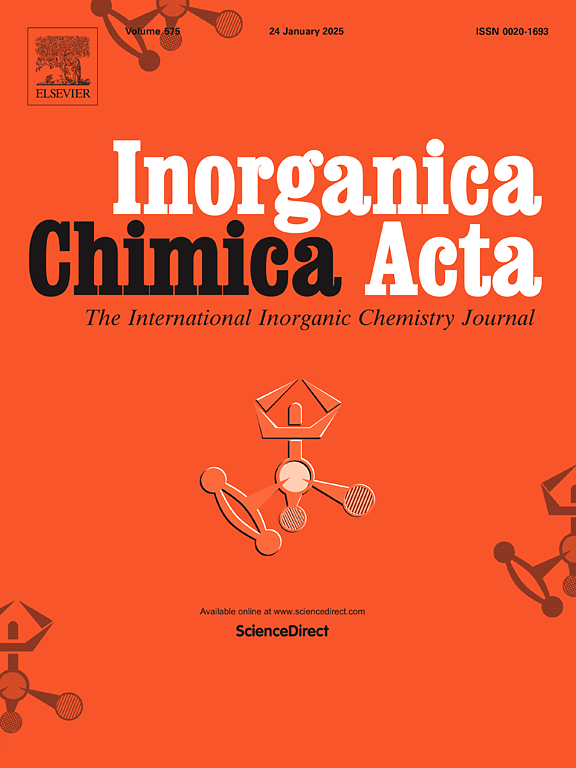基于香豆素的Al3+选择性开启荧光探针及其实际应用
IF 3.2
3区 化学
Q2 CHEMISTRY, INORGANIC & NUCLEAR
引用次数: 0
摘要
合成了香豆素和尼古丁肼合成的Al3+选择性开启荧光探针MCNH。MCNH探针在DMF缓冲溶液中对Al3+表现出良好的选择性,在UV暗箱中颜色由无色变为蓝色。MCNH与Al3+成2:1键。探针MCNH及其配合物的量子产率分别为1.36%和33.97%。探针MCNH对其他共存金属离子具有良好的抗干扰能力。该方法的检出限为0.45 μM,低于WHO规定的饮用水中Al3+的最大浓度。探针对Al3+的响应时间为120 s,适宜的pH范围为4 ~ 7。通过核磁共振滴定实验、质谱分析和DFT计算对识别机理进行了研究。此外,MCNH探针成功应用于测试条纹和荧光膜中,用于检测液态和固态Al3+。本文章由计算机程序翻译,如有差异,请以英文原文为准。

A selective turn-on fluorescent probe for detecting Al3+ based on coumarin and its practical application
A selective turn-on fluorescent probe MCNH for Al3+ derived from coumarin and nicotine hydrazide was synthesized and characterized. Probe MCNH exhibited a good selectivity towards Al3+ in DMF buffer solution accompanied by color change from colorless to blue in UV dark box. MCNH bond with Al3+ in a 2: 1 mannner.
The quantum yield of probe MCNH and its complex was found to be 1.36 % and 33.97 %, respectively. Probe MCNH has good anti-interference ability against other coexisting metal ions. The detection limit was estimated to be 0.45 μM, which was lower than the maximum concentration of Al3+ in potable water specified by WHO. The response time of the probe to Al3+ was 120 s and the suitable pH range was 4–7. The recognition mechanism was studied by NMR titration experiment, mass spectrometry analysis and was supported by DFT calculations. Furthermore, probe MCNH was successfully applied in test stripes and fluorescent film for detecting Al3+ in liquid and solid state.
求助全文
通过发布文献求助,成功后即可免费获取论文全文。
去求助
来源期刊

Inorganica Chimica Acta
化学-无机化学与核化学
CiteScore
6.00
自引率
3.60%
发文量
440
审稿时长
35 days
期刊介绍:
Inorganica Chimica Acta is an established international forum for all aspects of advanced Inorganic Chemistry. Original papers of high scientific level and interest are published in the form of Articles and Reviews.
Topics covered include:
• chemistry of the main group elements and the d- and f-block metals, including the synthesis, characterization and reactivity of coordination, organometallic, biomimetic, supramolecular coordination compounds, including associated computational studies;
• synthesis, physico-chemical properties, applications of molecule-based nano-scaled clusters and nanomaterials designed using the principles of coordination chemistry, as well as coordination polymers (CPs), metal-organic frameworks (MOFs), metal-organic polyhedra (MPOs);
• reaction mechanisms and physico-chemical investigations computational studies of metalloenzymes and their models;
• applications of inorganic compounds, metallodrugs and molecule-based materials.
Papers composed primarily of structural reports will typically not be considered for publication.
 求助内容:
求助内容: 应助结果提醒方式:
应助结果提醒方式:


